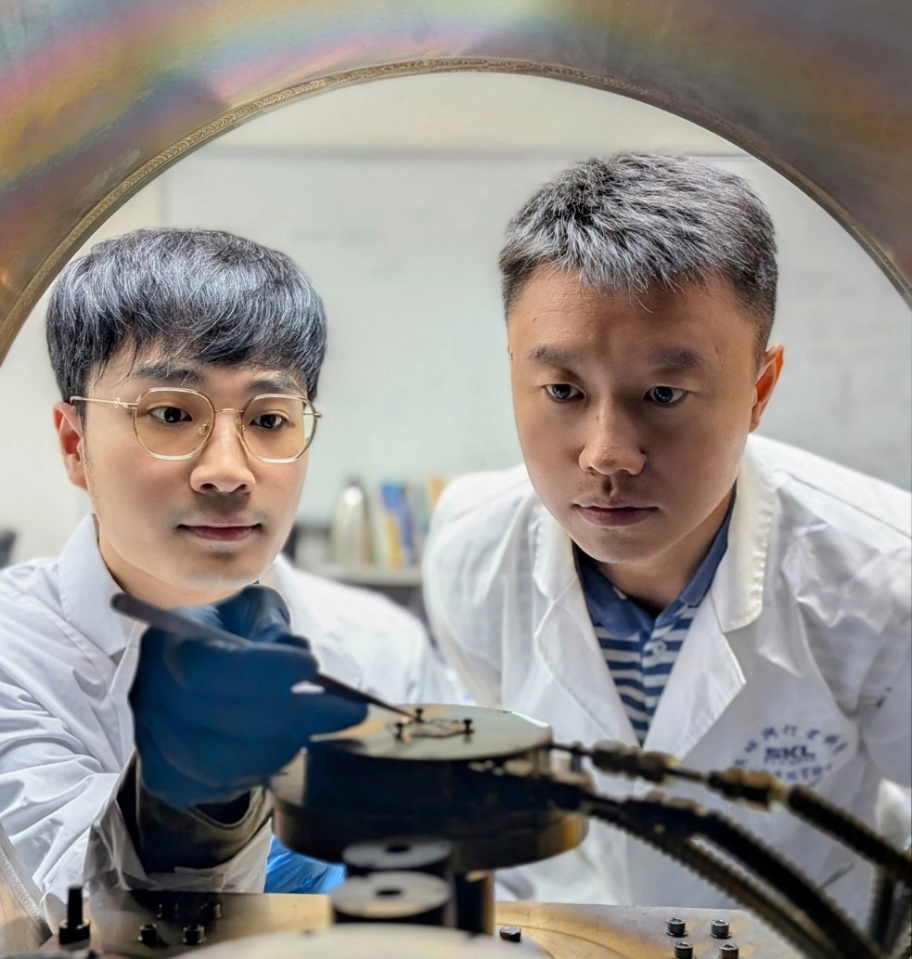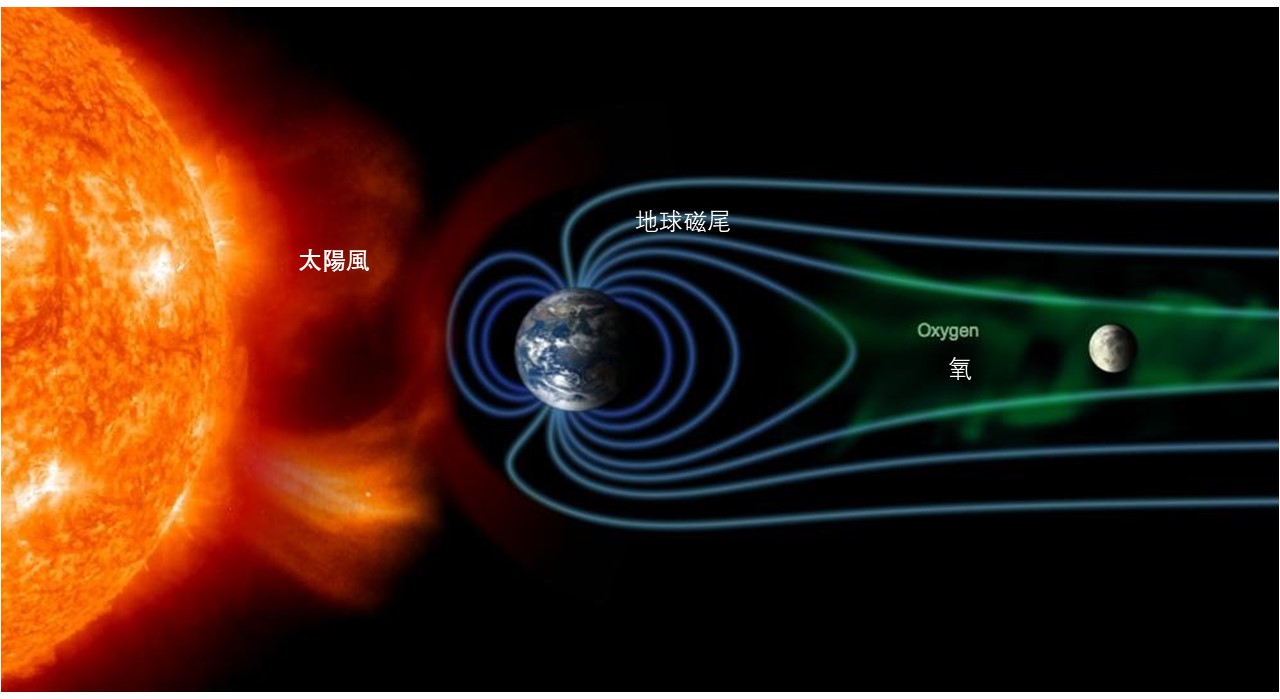Due to the absence of an atmosphere and magnetic field, extraterrestrial materials are continuously exposed to various types of space plasma radiation, undergoing vast physicochemical transformations. This process, which has been integral to the evolutionary history of the solar system's matter, is a focal point in planetary science and the study of extraterrestrial samples. Assistant Professor Ziliang Jin and Postdoctoral Fellow Xiandi Zeng from the State Key Laboratory of Lunar and Planetary Sciences at the Macau University of Science and Technology have made significant advances through a series of systematic ion radiation experiments on their space process simulation experimental platform, providing new insights into the early sources of water in the solar system and the intense oxidation processes on the lunar surface.

Assistant Professor Ziliang Jin (on the right) and Postdoctoral Fellow Xiandi Zeng (on the left) are observing the irradiated sample.
Since the formation of our solar system, all materials within it have been continuously exposed to radiation from various types of charged particles, predominantly hydrogen ions. It is widely believed that when these hydrogen ions impact on the solid surfaces of celestial bodies, they disrupt the structure of silicate minerals, such as olivine, and then bond with oxygen to form hydroxyl (OH) groups and even water (H2O). This process not only profoundly affects the generation of water on airless bodies like tiny dust particles, the Moon, and Mercury, but also may have provided the initial hydrogen reservoir for early planetary embryos. However, many environmental conditions affecting the occurrence of irradiated hydrogen in minerals are still unclear, typically mineral orientations and high radiation temperatures. To address these uncertainties, researchers have performed a low-energy hydrogen ions implantation experiment into olivine, simulating the radiation of hydrogen ions on silicate minerals in the solar system.
Our results reveal that the amount and depth of implanted hydrogen depend on the crystal orientation, particularly in layers rich in Mg-O Octahedral, which show more resistance to ion irradiation. Furthermore, increasing temperatures can enhance the saturation and retention of implanted hydrogen. However, beyond a critical temperature (approximately 200°C), hydrogen levels stabilize. These findings highlight the critical role of crystal orientation and temperature in the irradiation process and suggest that irradiated hydrogen can persist in high-temperature environments like the surface of Mercury or during the early solar system.
Besides the full-scale space environment of the solar system, plasma solid reactions also play an important role in the coevolution of the Earth-Moon system. Recently, the hematite (Fe2O3), a key component of rust, was detected on the Moon via remote sensing data. Intriguingly, the Moon lacks Earth's oxygen-rich atmosphere and substantial liquid water—essential elements usually required for rust to form. How, then, is iron on the Moon's surface rusting? The research team creatively designed ion radiation experiments to simulate the process of the lunar surface being irradiated by different space plasmas, revealing that oxygen ions from the earth's upper atmosphere are the key reason for oxidation.

Oxygen ions escaping from the earth's atmosphere are transported to the moon through the Earth's wind (from Osaka University/NASA)
The Earth is constantly bombarded by the solar wind, a stream of charged particles emitted from the sun. Notably, these solar wind particles can ionize the gas molecules in Earth’s upper atmosphere, causing them to escape into space and accelerate along the magnetotail, a phenomenon called "Earth wind." The primary components of Earth wind include ions of hydrogen, oxygen, and nitrogen. During orbiting around the Earth, the Moon spends about six days each month within Earth's magnetotail, where it is bombarded by these ions from Earth wind. Considering this essential oxidization condition for lunar rusting, the research team designed experiments with high-energy oxygen ion radiation to simulate the oxidation of iron-containing minerals on the lunar surface. They also conducted simulations of the reduction processes for oxidized products using high-energy hydrogen ions from Earth wind and low-energy hydrogen ions from the solar wind.
Our results demonstrate that Earth wind oxygen ions can anhydrously oxidize iron-containing material to hematite on lunar surface. High‐energy hydrogen ions can reduce hematite to metallic Fe, while low‐energy hydrogen ions are largely ineffective. Consequently, hematite retention depends on the ratio of oxygen and hydrogen ions from Earth wind impacting the lunar surface. These findings explain how Earth wind originating from the Earth's outer atmosphere is a trigger for the "rusting" of the lunar surface and why this "rust" predominantly occurs in high-latitude regions. More importantly, Earth's outer atmosphere has had the presence of oxygen since the Great Oxidation Event over 2.4 billion years ago. This suggests the possibility of continuous transport of Earth's oxygen or other particles to the lunar poles since that time. The upcoming Chang'e-7 mission to the lunar polar regions may help us unveil the mysteries of potential material transfers within the Earth-Moon system.
Two aforementioned research have been published under the titles "Effects of Crystal Orientation and Temperature on Space Irradiation of Silicates" and "Earth Wind‐Driven Formation of Hematite on the Lunar Surface" in the authoritative international journals, The Astrophysical Journal and Geophysical Research Letters respectively. Moreover, Nature News published a feature article titled " The Moon is rusting — thanks to ‘wind’ blown all the way from Earth," highlighting the second research concerning the intense oxidation on the lunar surface, which has garnered widespread attention from both the academic community and the public. Collaborators in the research include Professor Menghua Zhu from Macau University of Science and Technology; Associate professor Luyuan Xu from Beihang University; Professor Maitrayee Bose and Professor Richard Hervig from Arizona State University; Researcher Long Tao from the Institute of Geology at Chinese Academy of Geological Sciences; Professor Dong Chuanfei, Dr. Huang Ziyu, and Dr. Wang Liang from Boston University; and Professor Liam Morrissey from Memorial University of Newfoundland, among others.


Article lines: https://iopscience.iop.org/article/10.3847/1538-4357/adfec9;
https://agupubs.onlinelibrary.wiley.com/doi/10.1029/2025GL116170




























